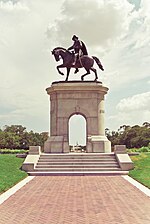Hermann Park is a 445-acre (180-hectare) urban park in Houston, Texas, situated at the southern end of the Museum District. The park is located immediately north of the Texas Medical Center and Brays Bayou, east of Rice University, and slightly west of the Third Ward. Hermann Park is home to numerous cultural institutions including the Houston Zoo, Miller Outdoor Theatre, the Houston Museum of Natural Science, and the Hermann Park Golf Course, which became one of the first desegregated public golf courses in the United States in 1954. The park also features the Mary Gibbs and Jesse H. Jones Reflection Pool, numerous gardens, picnic areas, and McGovern Lake, an 8-acre (32,000 m2) recreational lake.One of Houston's oldest public parks, Hermann Park was created on acreage donated to the City of Houston by cattleman, oilman and philanthropist George H. Hermann (1843–1914). The land was formerly the site of his sawmill. It was first envisioned as part of a comprehensive urban planning effort by the city of Houston in the early 1910s. Following the recommendation of a 1913 report which identified the then-rural area between Main Street and Brays Bayou as ideal for a large urban park, real estate investor and entrepreneur George H. Hermann, who owned most of the area and served on the city's parks board, bequeathed his estate to Houston for use as a public green space in 1914. By 1916, famed landscape architect George Kessler had completed a master plan for the park which was gradually implemented throughout the following decades. Ultimately, Hermann Park and Rice University are two clear expressions of the City Beautiful movement in Houston.The opening of the Houston Zoo in 1922 and the requisition of a large southern portion of the park for the establishment of the Texas Medical Center in 1943 fundamentally altered the scope and configuration of the space, though significant elements of the Kessler plan—such as the north-south axis extending from Montrose Boulevard—remain and have been expanded upon. Hermann Park experienced a period of neglect in the latter half of the 20th century due to a lack of funding and maintenance, spurring the formation of the nonprofit Hermann Park Conservancy in 1992. The Conservancy has since leveraged over $120 million of public and private funds to renovate and remake broad areas of the park. Today, Hermann Park welcomes over six million visitors annually; the Houston Zoo was the second most visited paid-admission zoo in the United States in 2016 (behind San Diego Zoo), with over 2.5 million visitors.Hermann Park is served by the Hermann Park / Rice University station on the METRORail Red Line, which runs along Fannin Street at the western edge of the park.
The Third Ward Redevelopment Council defines Hermann Park as being part of the Third Ward. T. R. Witcher of the Houston Press wrote in 1995 that the park and nearby areas are "not the first places that come to mind when you say "Third Ward,"[...]".









